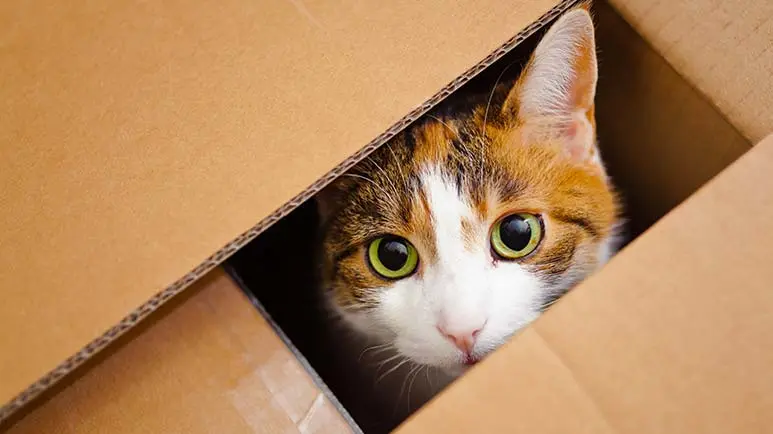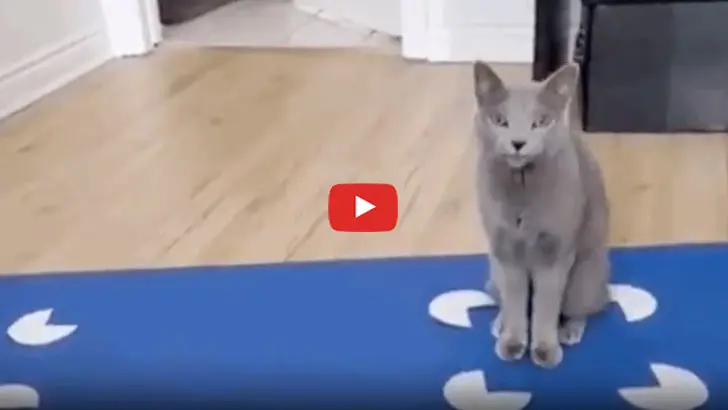Why Are Cats so Enticed by Boxes?
Apparently, all cats, no matter their size, wild or domesticated, have a thing for boxes. What is it about boxes and squares that attract cats, including shelter cats, almost like catnip?

STORY AT-A-GLANCE
- Zoo officials in Providence, RI put out a call on social media for empty boxes for their big cats, since all cats, no matter their size, wild or domesticated, have an affinity for boxes
- Part of the magic of cardboard boxes and other small spaces is that they help cats stay warm in environments that are typically cooler than they like it
- Research also shows that newly arrived shelter cats with access to hiding boxes adapt more quickly to their environment than those without boxes, are less stressed and more interactive with humans
- When it comes to boxes cats, like humans, can be fooled by optical illusions; a small citizen science experiment showed that cats will sit inside 2D shapes that only look like squares with about the same frequency as they’ll sit inside real squares
- Cats may be attracted to squares (and illusions of squares) as an extension of their love for boxes and other tight spaces
Not long ago, a Providence, RI zoo made a request for boxes on social media because “big cats love boxes, too.”1 If you’re a cat fan, you’ve likely run across any number of videos online featuring the fascination our feline friends have for small, enclosed spaces, and especially cardboard boxes.
And seriously, how cute is the sight of a big Maine Coon squeezing himself into a much smaller container, or a kitty diving headfirst into a cardboard box? Interestingly, as goofy as many cats behave when given access to an empty carton, there’s a quite practical reason for the feline love of boxes.
It’s All About Body Heat
If you have a cat at home, you’ve probably noticed that boxes aren’t the only small spaces your furry little friend likes to inhabit. It’s not unusual to find kitty curled up in a shoe on the closet floor, a bowl or coffee mug on the kitchen counter, an open shopping bag, a laundry basket, and even the bathroom sink.
There’s a good reason for this seemingly strange behavior: cats like it hot. Housecats feel most comfortable when their environment is 86° to 97°. In this temperature range, your kitty doesn’t need to expend metabolic energy trying to either warm up or cool down.
Needless to say, most humans require a significantly cooler temperature range to be comfortable — typically around 66° to 77°. Since most of us set our home thermostats to suit the humans in the household, our feline family members must find ways to warm up their immediate environment.
Cardboard boxes provide insulation, and small spaces in general require your cat to curl up, which preserves body heat.
Study: Boxes Reduce Stress in Shelter Cats
A team of researchers from the Faculty of Veterinary Medicine, University of Utrecht in the Netherlands, conducted a study of stress in shelter cats. Shelters are known to be extremely stressful environments for cats. The researchers discovered that access to hiding boxes reduced feline stress, especially in new arrivals to the shelter.2
The study involved 19 newly arrived cats at a Dutch animal shelter, only 10 of which were given access to hiding boxes. By day three of the cats’ shelter stay, the researchers observed a noticeable difference between the two groups. The cats with hiding boxes were acclimating faster to the shelter environment, were significantly less stressed than the kitties without boxes, and showed more interest in interacting with humans.
According to researcher Claudia Vinke, an ethologist at Utrecht University and lead author of the study, this makes perfect sense since the universal feline response to a stressful situation is to withdraw and hide.
“Hiding is a behavioral strategy of the species to cope with environmental changes and stressors,” Vinke told online publication WIRED.3
When cats in the wild feel threatened, they head for trees, dens, or caves to seek safety. Captive kitties don’t have that option, so hiding in boxes may be an adaptation.
The Maddie's® Shelter Medicine Program at Cornell University’s College of Veterinary Medicine provides care for homeless animals, and trains veterinary students and shelter staff in how to handle the unique challenges of keeping shelter pets healthy both physically and emotionally.
The experts at Maddie's® Shelter believe shelter cats benefit greatly when given the opportunity to hide when stressed. They recommend that shelters provide hiding boxes in the form of a simple cardboard box, a Hide-Perch-and-Go box, a plastic box or cage insert, a plastic carrier, or a commercially available cat den.
If you would like to be a part of this effort, the Animal Rescue Site provides one Cat Castle to a shelter cat for a $5 donation. The neat thing about this hiding box is that when a cat is adopted, the Cat Castle converts to a carrier to bring the kitty home in. Once home, the box can be converted back to provide a safe, familiar shelter that is already flooded with the cat's own scent. This can help kitty adjust more quickly and comfortably to her new home.
If I Fits, I Sits
In 2021, two researchers at Hunter College, City University of New York and a third at Australia’s La Trobe University published the results of a study of whether cats can be fooled into interacting with fake boxes.4 The results suggest that like humans, cats can indeed be tricked by optical illusions.
The experiments were conducted by pet parents at home (i.e., citizen scientists) who discovered their cats will sit inside 2D shapes that only look like squares with about the same frequency as they’ll sit inside real squares. Using tape to mark the outline of a square on the floor, the cat guardians discovered that many of their pets stepped right inside the lines and took a seat. #catsquare
Lead study author Gabriella Smith, a master’s graduate from Hunter College and animal cognition researcher, was inspired to do the study by her roommate’s cat. She set out to discover whether cats who hang out in empty boxes and park themselves inside shapes outlined on the floor would sit in an imaginary box.
The researchers asked the citizen scientist cat owners recruited for the study to create several different shapes on the floor using paper, scissors, and tape. One shape would be a typical square, but another would be a Kanizsa square illusion, which looks a bit like a pattern of Pacman shapes that trick the human brain to see a fully outlined square.
Once the shapes were down on the floor and the cats were let into the room, the owners recorded their behavior with a camera and smartphone so the researchers could monitor the experiment remotely. The owners were instructed not to interact with the cats and wore dark sunglasses so no eye contact could be made. If a kitty sat or stood inside a shape for at least three seconds, the trial was marked as successful, and their choice was recorded.

A total of 30 owners completed all six days of trials, and nine cats were “cooperative,” meaning they made a least one choice during the trials. Out of the 16 times a choice was made, cats sat on the square eight times, the square-like illusion seven times, and the control illusion (a Kanizsa-like shape that didn’t create an illusion) just once.
“The major takeaways are that cats are susceptible to the Kanizsa illusion in a human-like way, and are most likely attracted to 2D shapes for their contours (sides), rather than solely novelty on the floor,” Smith told Gizmodo. “Furthermore, this study illuminates how cats are great candidates for citizen science: They have so many quirky behaviors that are just waiting to be harnessed to study their cognition!”5











